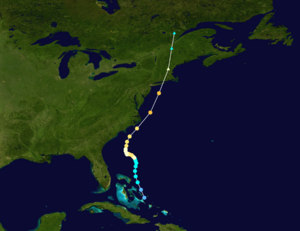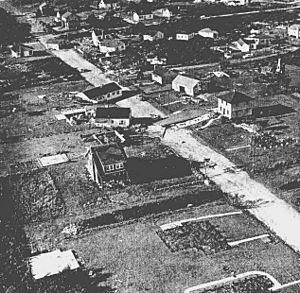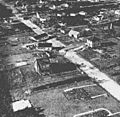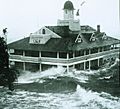Hurricane Carol facts for kids
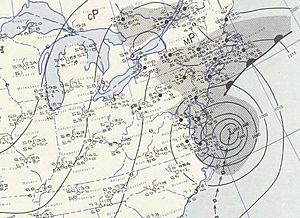
Surface weather analysis of Carol on August 31
|
|
| Meteorological history | |
|---|---|
| Formed | August 25, 1954 |
| Extratropical | August 31, 1954 |
| Dissipated | September 1, 1954 |
| Category 3 tropical cyclone | |
| 1-minute sustained (SSHWS/NWS) | |
| Highest winds | 115 mph (185 km/h) |
| Lowest pressure | 955 mbar (hPa); 28.20 inHg |
| Overall effects | |
| Fatalities | 72 |
| Damage | $462 million (1954 USD) |
| Areas affected | Bahamas, North Carolina, New York, New England, Southern Quebec |
|
Part of the 1954 Atlantic hurricane season |
|
Hurricane Carol was one of the worst storms to hit Connecticut and Rhode Island in the United States. It started as a small weather disturbance near the Bahamas on August 25, 1954. The storm slowly grew stronger as it moved northwest.
By August 27, Carol became a hurricane with winds of 105 mph (169 km/h). It then weakened a bit as it drifted northwest. A strong weather system later pushed the hurricane northeast. Carol then became a major hurricane. This means it had winds of at least 111 mph (179 km/h), or a Category 3 storm or higher.
As Carol moved along the coast of the Mid-Atlantic and Southeastern United States, it caused strong winds. It also created rough seas. This led to minor coastal flooding and small damage to homes. This happened in North Carolina, Virginia, Washington, D.C., Delaware, and New Jersey.
The hurricane then sped up and moved north-northeast. It hit land on eastern Long Island, New York, and then eastern Connecticut on August 31. At landfall, its winds were about 110 mph (177 km/h). Carol later changed into a non-tropical storm over New Hampshire on the same day.
In New York, strong winds on Long Island damaged about 1,000 houses. Around 275,000 people lost electricity. Many trees fell, and farmers lost a lot of their crops. The storm surge flooded LaGuardia Airport. It also covered the Montauk Highway, cutting off eastern Long Island.
Carol also brought strong winds and rough seas to coastal Connecticut, Rhode Island, and southeastern Massachusetts. About 150,000 people lost electricity and phone service. The storm destroyed 1,545 houses and damaged another 9,720. About 3,500 cars and 3,000 boats were also destroyed.
In New England, 65 people died and 1,000 were injured. The storm caused an extra $1 million in damage in Canada. Two people also died there. In total, Carol caused 72 deaths. It caused $462 million in damage (in 1954 money). This made it the most expensive hurricane in U.S. history at that time. The name "Carol" was used again for a storm in 1965. But it was later permanently removed from the list of hurricane names.
Contents
How Hurricane Carol Formed and Moved
A weather system called a tropical wave created a tropical depression. This happened over the northeastern Bahamas on August 25. It moved north-northwest and became a tropical storm on August 26. This storm was named Carol.
Carol slowly turned north and got stronger. On August 26, special planes called Hurricane Hunters flew into the storm. They reported that Carol already had an eye, even though it was still a tropical storm. The next day, Carol became a hurricane. It was about 345 miles (555 km) east of Cape Canaveral, Florida.
A large area of high pressure over the southeastern U.S. made Carol drift northwest. The hurricane kept getting stronger. On August 28, Carol reached its first peak strength with winds of 105 mph (169 km/h). It stayed at this strength for 30 hours. Carol then weakened a little off the coast of Georgia.
A strong weather system moving eastward helped Carol speed up. It turned north and then north-northeast. On August 30, the hurricane became a Category 2 storm again. It was 180 miles (290 km) east of Savannah, Georgia.
Early on August 31, Carol passed very close to Cape Hatteras, North Carolina. Planes estimated its winds were between 75 and 125 mph (121–201 km/h). The hurricane continued north-northeast at up to 39 mph (63 km/h). Carol became even stronger. It hit eastern Long Island as a Category 3 hurricane. Its strongest winds were 115 mph (185 km/h).
After quickly crossing Long Island Sound, the hurricane hit land again near Groton, Connecticut. Carol kept its small size and clear eye. People on eastern Long Island and in Groton, Connecticut, saw blue skies and light winds as the eye passed over. Then, strong hurricane-force winds returned. The storm's strength at landfall was based on a pressure reading of 957 mbar (28.26 inHg) in Groton. In the Groton Long Point area, 90% of homes were destroyed by the storm surge and winds.
Carol quickly lost its tropical features as it moved over eastern Massachusetts. It became a non-tropical storm over southwestern New Hampshire late on August 31. The powerful storm continued north. It then lost its identity after entering Canada, over southern Quebec.
Hurricane Carol's Impact on the United States
Mid-Atlantic States Feel Carol's Power
Before Carol reached North Carolina, a hurricane warning was issued. This warning covered areas from Wilmington to Manteo. Storm warnings were also issued south to Charleston. People living along the ocean north of Wilmington moved to safer places.
As Carol passed by North Carolina, its strongest winds stayed to the east. However, winds of 90 to 100 mph (140–160 km/h) were reported at Cape Hatteras. Further inland, Wilmington had a wind gust of 55 mph (89 km/h). Cherry Point had gusts up to 65 mph (105 km/h). These winds damaged corn and soybean crops. High winds also caused minor damage to roofs and homes. They knocked down some trees and power lines. Near the coast, waves damaged fishing piers. Flooding was reported in New Bern. High waves also damaged roads along the coast. Total damage in North Carolina was about $228,000.
Carol passed 100 miles (160 km) east of Virginia. It brought 40 mph (64 km/h) winds to Virginia Beach. Norfolk received 4 inches (100 mm) of rain. Further northwest, the rain helped ease drought conditions in the Washington, D.C. area. Damage was minor from Virginia to Delaware, where only light rains fell. Some rain also reached Pennsylvania.
In New Jersey, strong winds knocked down power lines, killing two people. Along the coast, high waves damaged boardwalks and caused flooding. In Pennsylvania, Carol caused a tractor to crash into a train, killing two people. Damage in Pennsylvania was estimated at $250,000.
On eastern Long Island, where Carol hit, the air pressure dropped to 960 mbar (28 inHg). Winds on the island gusted to 125 mph (201 km/h). This left thousands of homes without power. Many trees fell, and fruit crops were heavily damaged. Strong winds damaged many homes, boats, and cars. About 1,000 houses were damaged, and 275,000 people lost power. The hurricane's storm surge covered the Montauk Highway in Montauk. This cut off eastern Long Island for a while. Flooding also affected LaGuardia Airport. Because the storm was small, areas west of Fire Island were mostly unharmed. New York City had power outages but little damage. Damage in New York was estimated at $5 million. One person died, even though thousands of people had moved to safety.
New England and Canada Face Major Damage

Hurricane Carol brought strong winds across New England. These winds destroyed almost 40% of the apple, corn, peach, and tomato crops. This happened from eastern Connecticut to Cape Cod. Total crop damage was about $22.25 million. The hurricane destroyed thousands of homes in New England. Many were ruined by water or strong winds. In total, 11,785 families were affected. This included 9,720 damaged houses and 1,545 destroyed houses.
High winds left over 150,000 people without power in New England. This might have been one-third of all homes in the region. Many people also lost phone service. The hurricane also destroyed 3,500 cars and 3,000 boats. Heavy rain caused traffic accidents but only minor flooding.
Across the United States, Hurricane Carol caused $461 million in damage. Most of this was in New England. This made it the most expensive Atlantic hurricane at the time. There were 65 deaths in New England and about 1,000 injured people. Even with the high damage, many lives were saved. This was because people had warnings before the storm. The 1938 New England hurricane affected the same area with similar strength but killed 488 people. However, some areas did not get warnings. This was because power outages stopped people from getting Weather Bureau alerts.
Hurricane Carol hit Connecticut just after high tide. The storm surge, which was 10 to 15 feet (3.0–4.6 m) high, caused widespread flooding. This happened from New London eastward. About 2,000 people were stuck when a train line between New Haven and Rhode Island flooded. The most rain fell in New London, with up to 6 inches (150 mm). The wind also blew off part of the city hall roof. These strong winds left most of eastern Connecticut without power. Near the coast, strong winds and the storm surge damaged or destroyed thousands of buildings. This included 100 destroyed houses. Many other homes in Eastern Connecticut were damaged by falling trees. Thousands had moved to safety before the storm. One person died in the state. Because the storm was small, western Connecticut was not much affected. Total damage in Connecticut was about $50 million.
The hurricane set a record for wind gusts in Block Island, reaching 135 mph (217 km/h). On mainland Rhode Island, winds reached 90 mph (140 km/h) in Warwick, with gusts up to 105 mph (169 km/h). When Carol hit at high tide, it caused a storm surge of up to 14.4 feet (4.4 m) in Narragansett Bay. This was higher than the 1938 New England Hurricane. The storm surge flooded downtown Providence with 12 feet (3.7 m) of water. News reports said the floods covered the area with 4 feet (1.2 m) of water in about an hour. The winds knocked down two broadcasting towers in the city.
Westerly was also flooded, and 200 homes were washed away. There was heavy damage in Newport, where the Newport Casino was damaged. Some entire coastal towns were almost destroyed. In Rhode Island, 620 houses and 83 other buildings were destroyed. The winds tore off the roofs of hundreds of buildings. This forced many people to go to shelters during the storm. The powerful winds also knocked down thousands of trees and power lines. This caused a power cut for the entire state. It also stopped 95% of phone service. Damage in Rhode Island was about $200 million. At least 17 people died there.
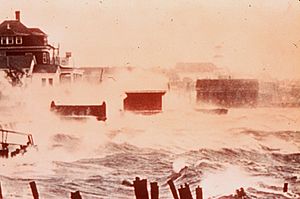
Before Carol hit, 20,000 people left Cape Cod. In Massachusetts, the hurricane brought winds between 80 and 110 mph (130–180 km/h) to much of the eastern part of the state. Gusts reached 80 mph (130 km/h) at Blue Hill Meteorological Observatory. The highest gusts in the state were around 125 mph (201 km/h). The winds knocked down about 50 million board feet of trees. Many of these fell onto power lines. Much of eastern Massachusetts lost power during the storm. Carol caused about $15 million in crop damage in the state. The winds destroyed most of the corn crop. They also destroyed about half of the peach crop and about 1.5 million bushels of apples.
Heavy damage was reported throughout Boston. High winds destroyed the spire of the Old North Church. This is where lanterns were hung during Paul Revere's ride. This spire was a replacement, as a hurricane in 1804 destroyed the original. In Wareham, about 1,500 people lost their homes. Across the state, 3,350 homes were damaged, and another 800 were destroyed. The hurricane destroyed 213 other buildings and severely damaged more. Near the coast, strong storm surges were reported. A 20 foot (6.1 m) storm tide was reported at New Bedford, setting a record. At least 15 people died in Massachusetts. Damage was estimated at $175 million.
In Dedham, Massachusetts, the hurricane knocked down the 80-foot bell tower. This was on the East Dedham firehouse, which is the oldest wooden firehouse in the country. The tower flew across the station. It landed on 219 Bussey St, the house next door. Louise Guerrio was feeding her one-year-old son, Joseph, inside. It also crushed three cars parked on Bussey St.
Carol stayed strong as it moved inland. Its winds were powerful enough to knock down trees and power lines in New Hampshire. One tree fell onto a car, killing a person. There were three deaths in total in the state, along with $3 million in damage. One person also died in neighboring Vermont.
Carol brought winds of up to 80 mph (130 km/h) in Augusta, Maine. Across Maine, the winds knocked down hundreds of trees. Some of these damaged houses, wrecked cars, destroyed one building, or fell onto power lines. Fallen trees blocked highways. One person was hurt by a falling tree branch. Downed power lines left several counties without power or phone services. The winds flattened hundreds of acres of corn in North Livermore. There was heavy damage to the apple crop across the state. Damage to apples was $1.7 million. As it moved west of Maine, the hurricane dropped heavy rain. One report showed 2.15 inches (55 mm) in 12 hours. Along the coast, high waves damaged boats. In Maine, the hurricane killed three people, injured at least eight, and caused $10 million in damage. This was the most expensive natural disaster in Maine's history at the time. Carol lost this record 10 days later when Hurricane Edna caused $15 million in damage in the state.
In Canada, rainfall peaked at 4.27 inches (108 mm) in Quebec. In Yarmouth, Nova Scotia, wind gusts reached 47 mph (76 km/h). In Quebec, the leftover storm from Carol knocked down trees and power lines in Montreal. Wind gusts were as high as 55 mph (89 km/h). Many power outages were reported in New Brunswick and Quebec. Fallen trees hit three cars in Saint John, New Brunswick. Flights were canceled. Road underpasses were flooded. Damage in Canada totaled about $1 million (1954 Canadian dollars). Two people were killed.
What Happened After Hurricane Carol
Governor of Rhode Island Dennis J. Roberts declared martial law for the state. This happened after Carol caused a lot of damage. In Massachusetts, the National Guard was sent to six towns to stop looting. National Guardsmen flew a plane of dry ice from Newark, New Jersey to Boston. This was to help areas without power and refrigeration.
Many areas were without power for days, some for up to a week. Crews worked to fix the downed lines. Spoiled food due to no refrigeration caused about $1 million in losses. Power crews from other parts of the United States came to help. Workers quickly removed trees from highways. Damaged factories in Rhode Island stopped employees from working for three weeks. The steeple of the Old North Church in Boston was rebuilt in 1955. People across the country donated $150,000 for this.
Governor of Maine Burton M. Cross declared a state of emergency for Maine. The Small Business Administration said six counties in Maine were disaster areas. Days after the storm, President of the United States Dwight Eisenhower declared Massachusetts and Rhode Island federal disaster areas. The government gave financial help, with $1.5 million going to Massachusetts. The president ordered troops to help with the cleanup. The American Red Cross quickly sent teams to the worst-hit areas, feeding hundreds of families.
About 12 days after Carol, Hurricane Edna hit eastern Massachusetts. This caused another $40 million in damage and 20 deaths. More disaster aid was given after this second hurricane.
The heavy damage from Carol and other hurricanes in 1954 led the U.S. government to start the National Hurricane Research Project. Hurricane Hunters and the Weather Bureau collected information on later hurricanes. They wanted to learn about their structure. They also tried to weaken storms using silver iodide through Project Stormfury.
Because of the huge damage, the name Carol was removed from the list of tropical storm names for 10 years. The name was used again in the 1965 season. But it was permanently removed in 1969. This was because the 1954 hurricane was still being studied. The new name chosen was Camille, which was used soon after in the 1969 season.
Images for kids
-
Edgewood Yacht Club withstands the storm surge from Carol in Rhode Island.
-
Storm surge from Hurricane Carol in Connecticut.
See also
 In Spanish: Huracán Carol (1954) para niños
In Spanish: Huracán Carol (1954) para niños
- List of North Carolina hurricanes
- Hurricane Bob (1991) – a storm with a similar path and strength
- Hurricane Irene (2011) – a hurricane that also hit New England
- Hurricane Sandy (2012) – this storm broke many of Carol's records, including being the most expensive hurricane in New England


